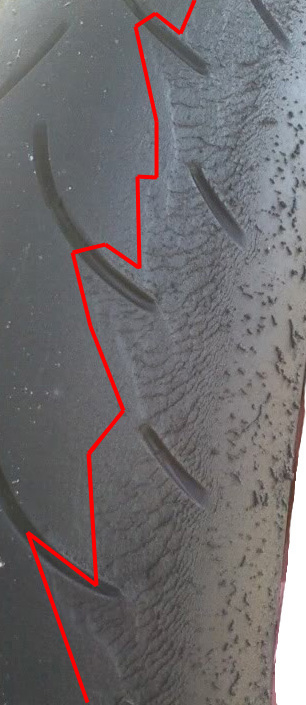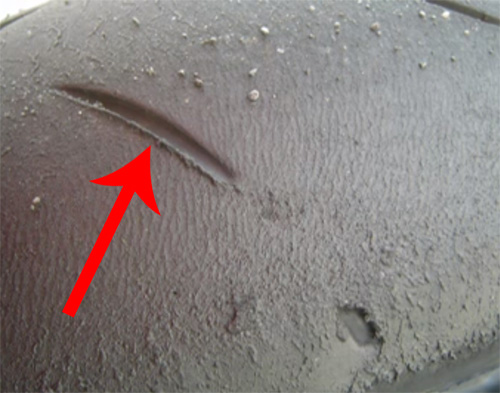Cold Tear
Cause – Cold tear is caused by the tyre being overinflated. When the tyre is overinflated the contact patch on the ground is too small so it cannot generate heat that is widespread enough to bring the carcass of the tyre up to operating temperature. Instead what happens is the surface of the tyre super heats very quickly while the carcass stays below operating temperature, so the surface of the tyre is ripped straight off.
Symptoms – The tears are in fact quite deep into the carcass and are somewhat fingernail shaped. If you can get a fingernail under them and almost peel a sizable chunk of the rubber back off the surface of the tyre then this is a sure fire sign of cold tear.
Hot Tear
Cause – Hot tear is caused by the tyre being underinflated. An underinflated tyre causes the contact patch to be too large on the ground which in turn means the tyre overheats. When the whole of a tyre over heats, the surface gets hot and is melted off very quickly and is pitched away due to the centrifugal force created when the tyre spins.
At first glance it’s quite similar to cold tear but because the whole tyre is overheating instead of just the surface, the rubber comes off with less effort as opposed to being ripped off a cold carcass like you see with cold tear, this then means hot tearing isn’t as deep.
Symptoms – As said above, it doesn’t take as much for the surface rubber to come off of an underinflated tyre because the whole tyre is overheating, so the tears on a tyre experiencing hot tear are fairly shallow and more spread out and you shouldn’t be able to get a fingernail deep under them like you can with a cold tear.
Also you will notice when looking at the tyre that the tears come down and into the centre of the tyre in an arc shape because of the centrifugal force of the tyre.
Suspension Related Tyre Wear
When we start talking about suspension and how incorrect settings can affect tyre wear, it’s difficult to explain what symptoms mean what because not every form of wear is unique to one particular component of the suspension. However, below I have outlined some points that should help you better determine if your tyre problems could possibly be suspension related.
If your rear suspension settings (rebound, compression, sag or spring rate) are incorrectly set to the point where they are then asking the tyre to act as a part of the suspension, you are immediately going to see some unusual wear or tearing because the tyre simply wasn’t designed to be used in that way.
To the untrained eye, tyre wear brought on from incorrect suspension settings could quite easily be palmed off as a pressure related problem (hot or cold tear), but there are some differences and some questions you can ask yourself to get you started on the right path to fixing it.
Do you know you have the right spring? – If your spring is either too hard or too soft for your weight, the carcass of the tyre will be put under a lot of strain because it’s being asked to act as a significant part of the suspension what with the spring not doing its job properly. This means the tyre ends up quickly shredding itself to pieces with incorrect loads.
Is the affected area uniform in width? – Have a look at the thickness of the tear. If you notice that the width of the tear is not uniform and changes considerably as you follow it around the tyre, then this is a good indicator that something is wrong with the suspension, usually rebound being out of adjustment. The picture to right demonstrates this.
Does the tear go all the way around? – If it does, that may be poor tyre pressure or geometry.
However if it doesn’t and you follow the tear around the tyre and notice that it is not a continuous tear i.e. there is an affected area, then there’s a sizable area where it’s clean, then there’s some more damage, then it goes clean again, this is another indication that a suspension setting is out, most probably rebound or compression, or even a combination of them both.
Are the edges of the tread raised? – If you have a raised area on either the leading or back edge of the tread, this is a strong sign that rebound damping on the forks or shock is set either too fast or too slow. Usually if it’s on the leading edge rebound is too slow, and if it’s on the back edge it’s too fast.
By answering the above questions, you should be able to determine whether or not you have a suspension related issue.
Geometry Tears
Not enough weight on the front
Cause – This type of motorcycle tyre wear is not quite as common as things like hot or cold tear as it comes from an incorrect geometry set up which usually affects the front tyre. What you see in the picture is a result of there not being enough weight on the tyre so it cannot get to operating temperature.
This means it cannot get proper grip or traction and as a result the front tyre pushes and drags across the ground when the rider gets on the throttle, rather than rolling over it as it should. The surface is then super heated and subsequently torn up.
Symptoms – With not enough weight on the front, what you’ll see is a much smaller band of tearing that looks very similar to hot tear on a rear tyre, only the band will be about 5-10mm thick, usually about half way between the centre of the tyre and the edge. Also, it will typically be uniform all the way around the tyre.
Too much weight on the front
 Cause – As the above heading would suggest, the other type of geometry tear is too much weight on the front. What happens in this instance is that when you start to turn the bike into a corner, because of the excessive weight on the front it will actually plough across the ground (rather than rolling), and it’s only when you have finished turning the bike and you get back on the gas that you take the weight away from the front end and the tyre is relieved.
Cause – As the above heading would suggest, the other type of geometry tear is too much weight on the front. What happens in this instance is that when you start to turn the bike into a corner, because of the excessive weight on the front it will actually plough across the ground (rather than rolling), and it’s only when you have finished turning the bike and you get back on the gas that you take the weight away from the front end and the tyre is relieved.
As well as having too much weight on the front, this type of tear can often be caused by the front end being too soft in conjunction with too much weight.
Symptoms – With a geometry tear where there’s too much weight on the front it will be the edge third of the tyre that is showing signs of incorrect wear, so the affected area is quite large.
If your tyre is showing bad wear patterns on the edge third, where the start of the wear pattern (the bit closest to the middle of the tyre) follows the circumference of the tyre uniformly, you can be pretty sure you’re suffering from geometry tear and have too much weight on the front.
Tyre Discolouration – Blue Tyres
You often see the question come up ‘why are my tyres blue’ or ‘what’s this blue stuff on my tyres’ with people suggesting that when you see it the tyres are done. This isn’t completely true.
What makes it blue? – Motorcycle tyres actually contain oils that keep the tyre soft and the blue/green tint you can see on your tyres is just the oils coming to the surface.
Why are they on the surface? – After the tyres have been used to the point where they gain significant heat, when they cool down again (this is one heat cycle) the oils in the tyre will often come to the surface. When you go back out and ride the bike these surface oils are scrubbed off and it’s only when you come back in and let the tyres cool down again that you’ll see more oils coming to the surface.
Each time you take a tyre through a heat cycle you are losing the oils that keep the tyre soft, so the more heat cycles a tyre has been through the less effective the rubber is going to be for you.
As a side note, heat cycles will affect track tyres a lot worse than road biased tyres, as road tyres are expected to go through these cycles.
What we want to see from our tyres
So we know what we don’t want to see in terms of tyre wear, but what DO we want to see?
Have a look at the picture to the right, this is what you’re looking for. If you have a pattern like the one in the picture which looks like a beach where the tide has gone out, you’ve nailed it.
This doesn’t mean to say it will give you optimum performance (racers often sacrifice tyre life for better performance) but it does mean you are highly likely to see great longevity from your tyre with enough grip for any track day rider.
Summary
Motorcycle tyres are very expensive and probably the biggest expense for any track day rider or racer (apart from track time maybe), so making sure we are best equipped to deal with a tyre wear problem if it crops up is extremely important for keeping your tyres, and your wallet in good condition.
Taking the above advice into account I would like to think you will now be able to spot some of the clues and tell tale signs that show up when we experience unsavoury tyre wear, and as a result get on top of it as soon as possible before it ruins your tyres.
It’s also worth noting however that this is a fairly simplified guide to tyre wear and tearing as there are a multitude of factors that come into play such as pressures, suspension make up, how the rider rides the bike, and even the nature of the track where the problems occur, so all I have intended to do for you here is give you some baseline knowledge so you can head in the right direction to getting your tyre problems fixed. Something I hope I’ve achieved.
Credit
I’ve got to give a lot of credit to Dave Moss for this article. The above is what I’ve learned from watching and reading a lot of the free information he gives out on judging tyre wear. There isn’t really a quality resource for this subject so we are very fortunate to have Dave do the best he can to teach us track riders about bike tyre wear problems.







